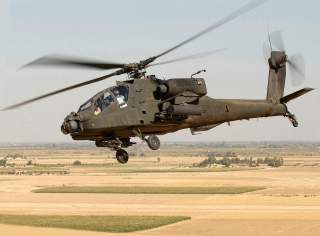It's a Deal: Army Wants Boeing to Build or Fix 600 AH-64E Apaches
What does this mean?
The E model is to be fit for maritime operations. The U.S. Army has expressed a desire to add extended-range fuel tanks to the AH-64E to further increase range and endurance.
The US Army plans to grant Boeing a multiyear contract for the production or remanufacture of up to 600 AH-64E Apache Guardian attack helicopters.
According to a US Army notice online, the contract would consist of a five-year multiyear contract or one-year contract with options from FY2022 to FY2026. Its value is still undisclosed. As told by Flight Global, the army intends on sole sourcing the work to Boeing and posted its plan online so as to give other potentially interested parties a chance to bid.
In 2017, Boeing and the US government signed the first five-year, $3.4 billion contract through which the Army, and an undisclosed foreign military customer, were to acquire the “E” variant of the Apache. As part of that contract, the US Army was to receive 244 remanufactured Apaches, while 24 new ones were to go to the international customer.
Formerly known as AH-64D Block III, in 2012, the Guardian was redesignated as AH-64E to represent its increased capabilities. The AH-64E features improved digital connectivity, the Joint Tactical Information Distribution System (JTIDS), more powerful T700-GE-701D engines with upgraded face gear transmission to accommodate more power, capability to control unmanned aerial vehicles (UAVs), full IFR capability, and improved landing gear. New composite rotor blades, which successfully completed testing in 2004, increase cruise speed, climb rate, and payload capacity. Deliveries began in November 2011. Full-rate production was approved on Oct. 24, 2012, with 634 AH-64Ds to be upgraded to AH-64E standard and production of 56 new-build AH-64Es to start in 2019/20. Changes in production lots 4 through 6 shall include a cognitive decision aiding system and new self-diagnostic abilities. The updated Longbow radar has an oversea capacity, potentially enabling naval strikes.
The E model is to be fit for maritime operations. The U.S. Army has expressed a desire to add extended-range fuel tanks to the AH-64E to further increase range and endurance.
The US Army’s intention to grant Boeing a five-year Apache production contract is a significant turnaround for the company as the programme hit a big snag last year. As already reported in fact, in February 2018 the U.S. Army halted the delivery of AH-64E attack helicopters because a strap pack nut on the main rotor was corroding in coastal environments. While Boeing was working on redesigning the nut since last year, the service decided to stop taking in new helicopters until the company fielded a new nut.
The nut in question holds very large bolts that subsequently hold the rotor blades on the helicopter and is a critical safety item.
Failure of the part resulted in the loss of an AH-64D and two crew members in 2016, according to the Pentagon’s director of operational test and evaluation.
Boeing met US Army conditions to restart production at its Mesa, Arizona facility in August 2018, but the issue appeared to knock the company off its delivery schedule. In 2018, it delivered zero new AH-64 Apaches, compared to 11 in 2017. In 2018, it delivered 23 remanufactured AH-64s, compared to 57 in 2017.
This article by Dario Leone originally appeared on The Aviation Geek Club in 2019.
Image: Wikimedia.

